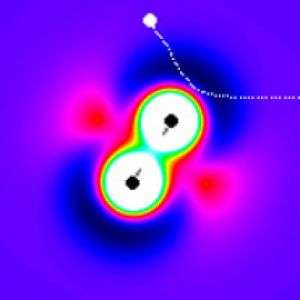Atomic Tug of War

A new form of energy-transfer, reported today in Nature (3 July 2008) may have implications for the study of reactions going on in the atmosphere, and even for those occurring in the body.
Imagine a simple molecule consisting of two atoms as being like two balls attached together by a spring. If an incoming atom strikes one side of the molecule, the spring compresses and you would expect the molecule to jump backwards – remember Newton's cradle? (http://en.wikipedia.org/wiki/Newton's_cradle)
However, research by Dr Stuart Greaves in the Chemistry department at the University of Bristol, suggests that, contrary to expectations, in certain conditions the molecule jumps forwards, not backwards.
Greaves and his colleagues studied fast hydrogen atoms colliding with supersonically cooled deuterium-deuterium molecules. On the occasions when the collision did not result in a chemical reaction, the hydrogen atoms scatter.
In these 'inelastic' processes, the scattering of the hydrogen atom is normally backwards. But in this case, the team found that the inelastic scattering process led mainly to forward scattering – the opposite of what was expected.
Stuart Greaves said: "The reaction under study is the simplest chemical reaction possible and yet it still continues to surprise us, even after 80 years of scientific investigation. Our work provides another vital piece of the jigsaw for understanding the mechanics of chemical reactions, such as those going on in the atmosphere."
The explanation of what is happening is that even if the hydrogen atom flies past the deuterium-deuterium molecule in a 'grazing collision', this can tug on the deuterium atom nearest to it, thereby extending the bond connecting the two deuterium atoms, which causes the molecule to move forwards.
Link to animations: www.dur.ac.uk/eckart.wrede/QCT … php?product=4&traj=1
Citation: Vibrational excitation through tug-of-war inelastic collisions, by Stuart J. Greaves, Eckart Wrede, Noah T. Goldberg, Jianyang Zhang, Daniel J. Miller & Richard N. Zare. Nature, 3 July, Vol 454, p. 88.
Source: University of Bristol





















